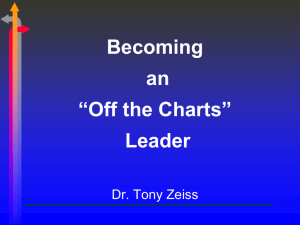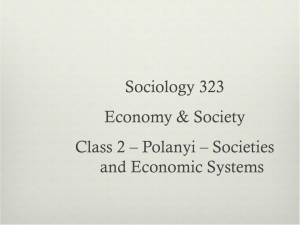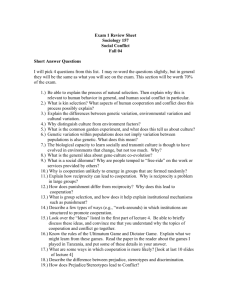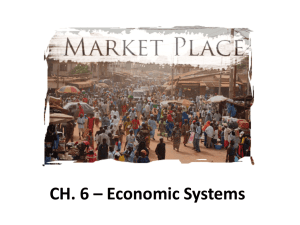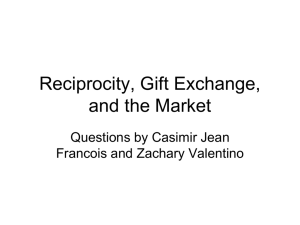Cultural Reciprocity
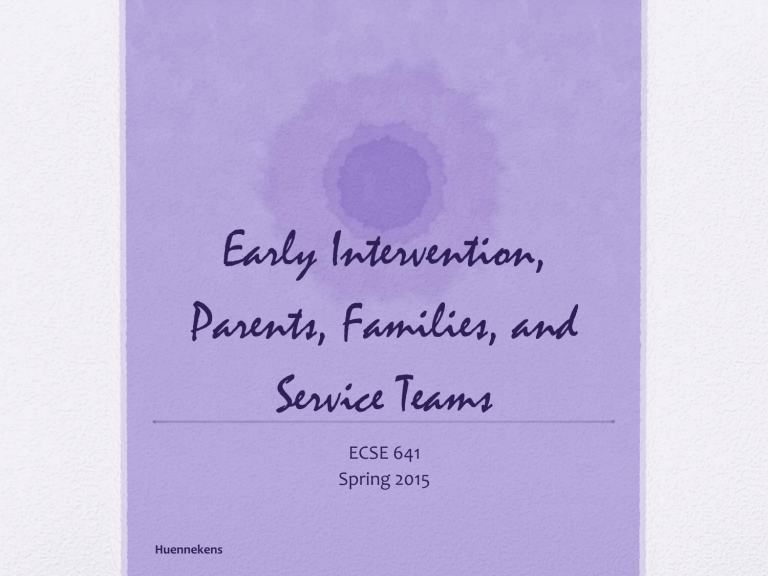
Early Intervention,
Parents, Families, and
Service Teams
ECSE 641
Spring 2015
Huennekens
Huennekens
Families
• List of different family profiles
• What do the families have in common
• What characteristics are unique
• How might these unique issues affect EI services
Huennekens
Bronfenbrenner
• https://youtu.be/5htRhvm4iyI
Huennekens
Family Systems Framework
Three levels of meaning
• the characteristics of the family as a unit
• family size, cultural background, socioeconomic status, geographic location, and educational attainment;
• personal characteristics
• the nature and age of onset of the exceptionality, family member health, and coping style;
• special challenges
• family poverty, parents with disabilities, and substance abuse
• (Turnbull, 2000; Turnbull et al., 2005)
Huennekens
Family Systems Framework
• Family interactions are the processes in the conceptual framework
• the marital subsystem (interaction between spouses)
• parental subsystem (interaction between parents and children)
• the sibling subsystem (interaction among siblings)
• extended family subsystem (interaction between the nuclear and extended family).
• Family function refers to family needs
• affection, self-esteem, socialization, education, recreation, daily care, spirituality, and economic stability
•
(Turnbull, 2000; Turnbull et al., 2005).
Huennekens
Family Systems Framework
• Family life cycle, (transition) - the change families experience over years,
• Changes in family characteristics, functions, and life roles.
• Examples are
• the birth of a child with an exceptionality;
• the transfer from the intensive care in the hospital to the home, from the EI system to programs for three-year-olds, from preschool to kindergarten;
• providing sexual education, expanding self-determination, and developing independence in adolescence;
• identifying post-secondary education and employment opportunities and seeking supported living options in adulthood,
• all of which can be categorized as either an expected or unexpected transition
• (Turnbull, 2000; Turnbull et al., 2005).
Huennekens
Family Systems Framework
• The expected transition is what a family has planned, such as a typically developing child transferring from preschool to kindergarten,
• The unexpected transition can be anything that happens unexpectedly to the family, like the child staying in the hospital for intensive care after birth, or the child being unable to attend school for a full day due to health issues.
Huennekens
Family-Centered Practice
1) Infants and toddlers learn best through every day experiences and interactions with familiar people in familiar contexts.
2) All families, with the necessary supports and resources, can enhance their children’s learning and development.
3) The primary role of the service provider in early intervention is to work with and support the family members and caregivers in a child’s life.
4) The early intervention process, from initial contacts through transition, must be dynamic and individualized to reflect the child’s and family members’ preferences, learning styles and cultural beliefs.
5) IFSP outcomes must be functional and based on children’s and families’ needs and priorities
6) The family’s priorities needs and interests are addressed most appropriately by a primary provider who represents and receives team and community support.
7) Interventions with young children and family members must be based on explicit principles, validated practices, best available research and relevant laws and regulations.
Huennekens
Early Childhood Outcomes
(ECO) Center
Office of Special Education Programs (OSEP) funded the Early Childhood Outcomes (ECO)
Center
• to promote the development and implementation of child and family outcome measures for infants, toddlers, and preschoolers with disabilities which could be used in local, state, and national accountability systems.
Huennekens
Early Childhood Outcomes
(ECO) Center
• Families understand their child's strengths, abilities, and special needs.
• Families know their rights and advocate effectively for their child.
• Families help their child develop and learn.
• Families have support systems.
• Families access desired services, programs, and activities in their community.
Huennekens
Discussion
• Family-centered practice
• ECO outcomes
• Turnbull framework
Commonalities of the above systems
Huennekens
Culture
• Next we will consider families, outcomes, and service providers in terms of cultural, socioeconomic, and linguistic diversity.
Huennekens
Huennekens
Cultural Reciprocity
ECSE 641
Spring 2015
Cultural Variant
Perspective
• Persons adhering to a cultural variant perspective systematically seek to preserve diversity by promoting culturally sensitive and culturally relevant practices when working with families (Coll, 1993).
• This perspective maintains that the family constructs its own meaning of their circumstances and the family’s values and cultural identity are reflected within their practices.
Huennekens
Cultural Reciprocity
• The concept of cultural reciprocity is rooted in the idea that people cannot be sensitive to cultural differences unless first they are aware of the cultural assumptions that guide their own thinking and behavior
Huennekens
Cultural Reciprocity
• One cultural assumption common in the
American mainstream that is related to
transition planning is that it is natural and desirable for adults to live independent of their parents.
Huennekens
Cultural Reciprocity
• It can also make cultural sense for adults to continue living in the household of an extended family that includes their parents.
Huennekens
Cultural Reciprocity
• If youth and families feel they have good relationships with personnel, then they are more likely to share their feelings and become real partners in transition planning and services.
Huennekens
Cultural Reciprocity
• Goes beyond awareness of differences to selfawareness
• Aims for subtle levels of awareness of difference
Huennekens
Cultural reciprocity:
• Has universal applicability.
• effective communication and collaboration come from listening to and respecting all perspectives.
• Avoids stereotypical solutions.
• Ensures that both families and personnel are empowered.
Huennekens
Using Cultural Reciprocity
• Effectively using the process of cultural reciprocity includes four steps:
• Step 1: Identify the cultural values underlying interpretations of the situations involving youth and families.
• Step 2: Explore the extent to which values and assumptions are recognized and accepted by the youth and family.
Huennekens
Using Cultural Reciprocity
• Step 3: Acknowledge any cultural differences, and explain to the youth and family how and why American mainstream culture promotes different values.
• Step 4: Collaborate with the youth and family to determine the most effective way of adapting professional interpretations and recommendations to the family value system.
Huennekens
Barriers
Two barriers can make cultural reciprocity difficult to achieve (Kalyanpur & Harry, 1999).
• One barrier is the extra time that might be needed to get to know youth and families and engage in dialogue.
Huennekens
Barriers
• The other barrier is the mistaken belief that only personnel who are themselves of CLD heritage can work effectively with CLD youth and families
(Kalyanpur & Harry, 1999).
Huennekens
The issue is not that we must have had the same experiences in terms of culture, ethnic background, race, socioeconomic status, or gender as the families we serve but that we have the willingness to learn about and understand their experiences, that we are willing to understand how our own experiences have shaped us, and that we respect and accept these differences in our various experiences
(Kalyanpur & Harry, 1999, p. 131).
Huennekens
Cultural reciprocity
• Respectful and trusting relationships are the foundation of success in any collaborative activity.
• Ask the questions!
Huennekens
Questions
• What languages are spoken in the home and by which members?
• What are the family’s norms for personal and social development for the child with disabilities
(e.g., what degree of independence is encouraged)?
• What personal and academic goals for the youth are held by the family?
Huennekens
Questions
• What are the family’s views on disabilities, and how does this affect their view on treatment for the youth?
• How is the family conceptualized—as a nuclear unit or as an extended family structure?
• How much legal knowledge about parental rights and advocacy does the family possess?
Huennekens
Questions
• What are the family’s decision-making practices?
Are they hierarchical, where elders hold the decision-making power, or are they oriented to individual rights with children expected to selfadvocate?
Huennekens
Cultural reciprocity
• It is important to note that culture influences parental styles of communication in transition planning meetings.
• For example, parents from Hispanic and Asian groups may have established patterns of interaction characterized by roles based on hierarchy, deference to authority, indirect confrontation, and maintenance of harmony and good relations.
Huennekens
Cultural reciprocity
• Alternative communication styles must be honored and respected rather than viewed as lack of involvement or agreement by the parents.
Huennekens
Cultural Reciprocity
• Cultural values and beliefs inform
• Definition of disability
• Special education policy and practice
• Roles of experts/Roles of parents (power differential)
• Professionals perspectives on parenting styles
• Cornerstone goals
Huennekens
Huennekens


